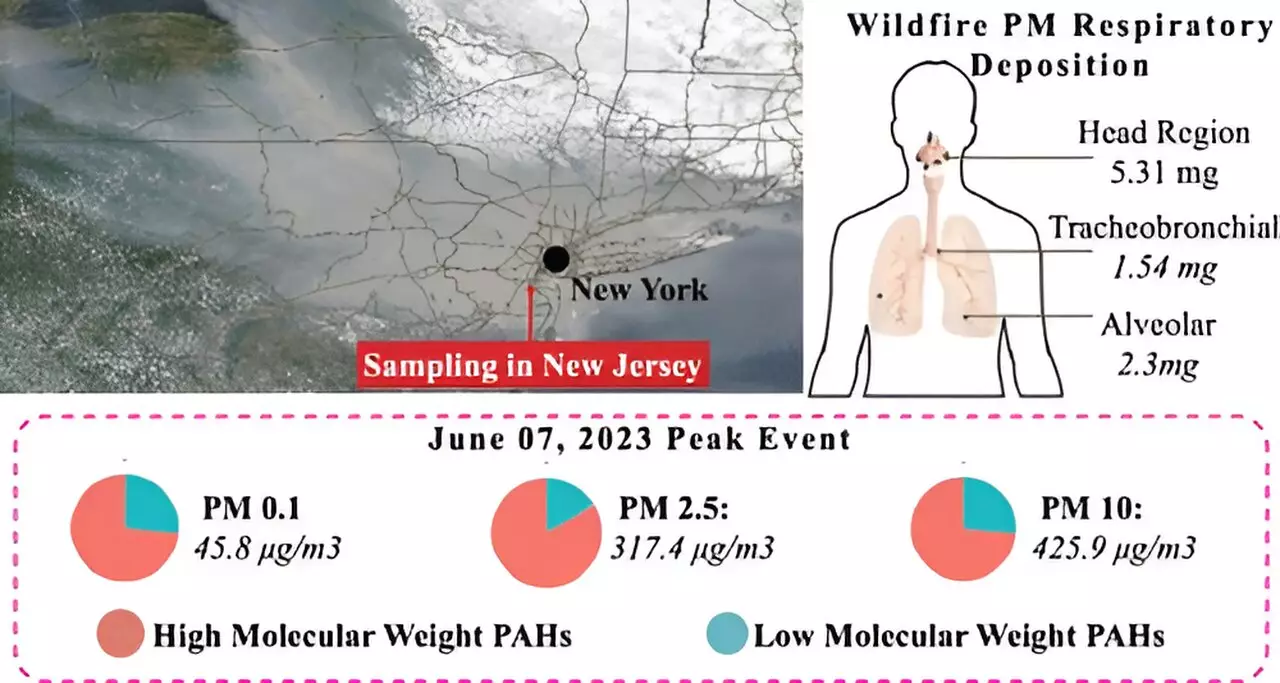In recent years, climate change has emerged as a critical factor influencing many environmental phenomena, including the increasingly frequent and intense wildfires across the United States. A study conducted by researchers at Rutgers University offers alarming insights into the ramifications of one such wildfire event that took place in June 2023, which significantly affected air quality across the Northeast, impacting over 100 million Americans. As we delve into the findings of this research, it becomes evident that the consequences of these climate-driven events extend far beyond the immediate disaster, significantly impacting public health, particularly in densely populated areas such as New Jersey and New York City.
Particulate matter (PM) has long been recognized as a significant environmental pollutant, one of the leading contributors to the global burden of disease. The Rutgers study highlights that the composition of PM from wildfires is particularly alarming due to the presence of harmful compounds such as high molecular weight polycyclic aromatic hydrocarbons (PAHs), known carcinogens. Lead author Jose Guillermo “Memo” Cedeño Laurent points out that the recent climate-driven wildfires are undoing decades of progress made in improving air quality in the U.S. The June 2023 incident serves as a stark reminder of how environmental disasters can quickly revert hard-won advancements in public health.
Emerging evidence indicates that wildfire-related pollution may pose more severe health risks than traditional pollution sources. For instance, new epidemiological studies have linked respiratory and cardiovascular emergencies in urban settings like New York City to this kind of pollution. These findings raise an essential question: What mechanisms are at play that elevate the health risks associated with wildfire smoke compared to other forms of air pollution?
The Rutgers team conducted an in-depth investigation into the particulate matter released during the wildfire, focusing on its physical and chemical properties. Their analyses revealed that, during the peak of the fire on June 7, the concentrations of ultrafine and fine particulate matter exceeded national air quality standards by nearly tenfold—a staggering statistic reflective of a significant public health crisis.
Cedeño Laurent and the team explored how these ultrafine particles could penetrate deep into the lungs, contributing to a range of health issues. The study estimated that an inhalation dose of over 9 micrograms of PM could be deposited in the lungs over a 72-hour period. This detail emphasizes the urgency of understanding and mitigating the risks associated with wildfire smoke exposure, particularly for vulnerable populations living in already polluted urban environments.
The implications of these findings extend beyond immediate health concerns; they signal a need for public health policies to adapt to the realities of climate change-induced wildfires. The study champions the necessity of further research into the complex interactions between wildfire smoke and human health. Insights from this research may be pivotal in guiding future health assessments and risk evaluation strategies, aiming to bolster community resilience against impending wildfire events.
The authors encourage health authorities and assessors to leverage this insight to create targeted response strategies that account for the unique properties of wildfire-related air pollution. With urban areas already grappling with various forms of air pollution, the additional burden of wildfire smoke presents a dual challenge that requires immediate attention.
As Cedeño Laurent notes, ongoing studies are crucial in understanding the broader implications of wildfire smoke on various organs, including the lungs, heart, brain, and reproductive systems. Interdisciplinary collaborations involving multiple institutions seek to uncover the health effects associated with particulate matter exposure, moving beyond reactively addressing symptoms to grasping the underlying biological mechanisms.
Additionally, the research from Rutgers has led to the exploration of the optical properties of particulate matter, a topic that will be further developed in an accompanying study. This branch of research aims to evaluate not only the direct health risks but also the impact of wildfire smoke on Earth’s temperature and the subsequent effects on climate change in urban settings.
The research coming from Rutgers University’s investigation into the air quality impacts of wildfires serves as an urgent reminder of the evolving threats posed by climate change. As wildfires become more commonplace, understanding the intricate relationships between such events, air quality, and public health becomes paramount. The combination of comprehensive research, proactive public health strategy, and community engagement will be critical in combating the escalating threat of wildfire smoke and ensuring a healthier future for urban populations across the Northeast and beyond.


Leave a Reply